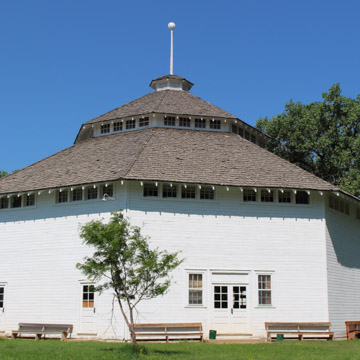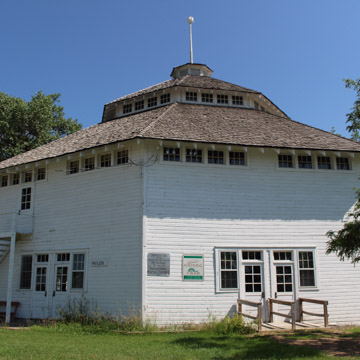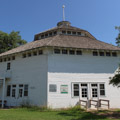The Butte-Lawrence County Fair Pavilion is the most iconic of the fairground’s twenty historic structures. In 1920, Butte County commissioners purchased the forty-acre site, located on the Belle Fourche River in Nisland, to be used as the site of the county agricultural fair, which had previously been located in Belle Fourche. Since 1979, Lawrence County (south of Butte County) has co-hosted the fair—a joint partnership that is somewhat unusual in South Dakota.
County commissioners hired local builder Earl Wilson to begin construction in 1921. Although work began that summer and the fair was held in September of that year, it is not known how many of the buildings were actually completed by that time. The Pavilion, which is used for agricultural exhibits and as a dancehall, is located on the eastern side of the fairgrounds. The octagonal, wood-frame structure is two-and-a-half stories tall and, like all the other fair buildings, rests on a concrete foundation. It is clad in shiplap siding and the octagonal monitor-style roof is clad in wood shingles. At the top of the monitor is an octagonal cupola, also wood-shingled, with wood slat vents on each elevation; it is topped by a substantial lightning rod. Exposed rafter tails beneath the cupola’s eaves hang over two sets of four multipane windows on each elevation. On five elevations, centered double doors are topped by transoms and flanked by six-over-six double-hung windows; on the sixth elevation, there are two individual doors located near the corners of the building. The remaining sides have no doorways. An exterior stairway leads to the only door on the second floor. The interior is a large open space with a balcony around the upper level. The original hardwood floors are intact.
Other buildings and structures at the fairgrounds include the grandstand, the groundskeeper’s house, the 4-H building, four additional exhibition buildings, six livestock barns, two small sheds, and the original outhouses. The grounds also contain three modern restroom and shower buildings. The fair’s claim to fame is a visit by President Calvin Coolidge and his wife, Grace, who attended the fair on September 1, 1927, while touring the Belle Fourche Irrigation Project (one of the first Bureau of Reclamation irrigation projects in the country).
The Butte-Lawrence County Fair is held annually every summer.




